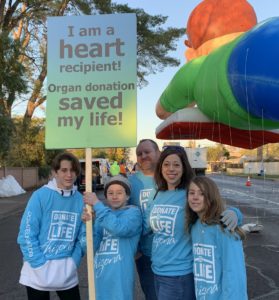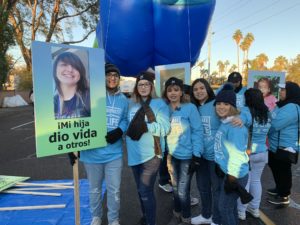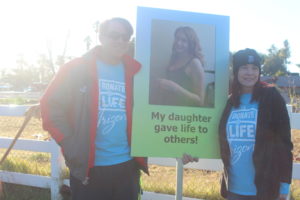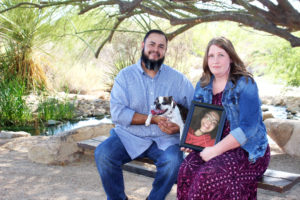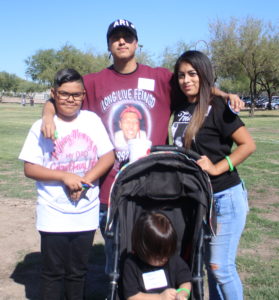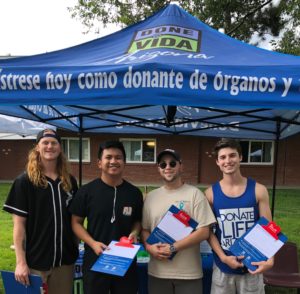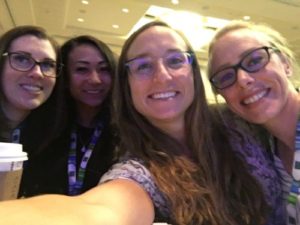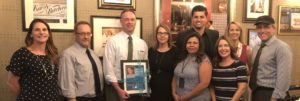Honoring Gift of Life at Fiesta Bowl Parade
Each year, Donate Life Arizona honors all who are touched by the gift of donation at the Fiesta Bowl Parade. Donor families and recipients walk side-by-side in Donate Life Arizona’s parade segment, showcasing the legacies created through organ, eye and tissue donation. Accompanying these touching stories was a giant balloon of Reggie, the Donor Cactus, and a passionate group of dancers who energized the crowd along the streets.
This year, 11-year-old Dylan McQueen was among those holding posters proclaiming his lifesaving gift. At eight months old, Dylan received a heart transplant. This transplant gave him the chance to grow up and go on to win a state championship in wrestling as well as four medals at the 2018 Transplant Games.
His mother says that with the gift of a healthy heart came another gift, “the gift of appreciating every day for what it is.”
In 2017, Graciela Sanchez walked in the Fiesta Bowl Parade with Donate Life Arizona for the first time, and made incredible connections along the way. Her daughter, Karen Hernandez, passed away at 18 years old and made an incredible impact on the world. Short as Karen’s time here was, her compassion continued when she saved and healed 23 people through organ and tissue donation. That compassion manifested in Karen’s heart recipient, whom Graciela met at the parade for the first time. Graciela walked in her daughter’s honor again in 2019, celebrating this renewed life.
Also proudly walking behind the enthusiastic Donate Life Arizona dancers was donor mom Dana Ayers. Dana held a poster honoring her 16-year-old daughter, Hannah Pairrett. Hannah was athletic, charitable and selfless. When she passed away earlier this year, she granted the gift of life to five others.
Every December, we are grateful for the opportunity to gather together and honor our loved ones while also showing support for donation. In these moments, we are able to see the impact that donation has and the true gift that life really is.
A Christmas Miracle
After a nomadic, military-family childhood, Jason Burruel and his parents put down roots in the Valley in 1981, and he started high school.
Fast forward to April 2016—married with two children—Burruel previously had a quadruple bypass, but it wasn’t enough. Doctors said he needed a new heart. The fear of his children growing up without him was a thought Burruel couldn’t bear.
After eight months on the waiting list, taking medication and hoping for a second chance, he got a Christmas miracle. Doctors prepped him for transplantation Christmas Eve 2016.
“It was the greatest gift I could ever be given,” Burruel says. “Even though I don’t know who my donor family is, I cannot say thank you enough. All I can do is take care of my new heart and live life to the fullest. In your honor.”
Following Burruel’s recovery phase post-transplant, he can play golf again, see his children graduate from college and continue to be a father and husband to his family. “Thank you, donor family. I want you to know the decision you made that holiday season changed our lives.”
Giving thanks for the gift of donation
November is a time to gather with loved ones and give thanks. It is also when we reflect on the healing gift of eye donation, as November is also Eye Donation Month.
This year, we celebrate Eye Donation Month by remembering Elijah Perez, a young man who saved lives and gave the gift of sight.
Elijah had a heart of gold—loving animals and children, often seen in pictures with him.
“When he passed, I got messages from his friends, and they all told me they knew Elijah because he helped them through a hard part in their life,” his mother, Crystal Aristizabal, says.
Elijah got his Arizona state ID when he was 17 years old, and he decided to check the box at ADOT MVD to be an organ and tissue donor.
Only one year later, he saved the lives of four people through organ donation.
“He showed his caring heart,” his mom says, saving and healing lives with this simple choice.
While you’re gathering with loved ones this holiday season, take a moment to be grateful for those whose selflessness saves and heals the lives of so many. While you’re at it, encourage your family and friends to register at www.DonateLifeAZ.org/register!
A Celebration of Life
Smiles were shared, stories were told, families embraced, and loved ones were honored on a warm October day at Steele Indian School Park. Marcel Pincince, director of Donor Family and Advocate Services at Donor Network of Arizona, spoke deeply to hundreds of donor families about the power of their love ones’ donation and how special the gift of life truly is. Families decorated “generosity rocks” to later serve in memory of someone they love, or to pass on to someone else as a reminder of the power of kindness.
More than 1,400 people came together Oct. 20, 2019, to honor organ, eye and tissue donors. The Celebration of Life provides an opportunity for families to celebrate their loved ones’ generosity while meeting other donor families, recipients, living donors and Donate Life Arizona volunteers. The family-friendly atmosphere included live music, bounce houses, lawn games, a photo booth, food, a memory garden and more.
Damion Arbizu attended the event with his family to honor his brother. He shared how the event was an incredible opportunity to reflect on family members who leave behind a legacy of generosity with their willingness to give the gift of life.
“This is our first year and we want to take it all in, but also acknowledge people who are going through the same thing,” Arbizu says. “I’m glad to be a part of something like this.”
Arbizu’s brother was generous and kind, always helping those less fortunate. When he passed, he donated tissue and organs, helping to save and heal the lives of others.
“He was the type to see someone who needed help and help them,” Arbizu says. “My brother was a real good person, real caring.”
Many took comfort in dedicating time to reflect on the legacies of these heroes, and share their journey of loss, hope and healing.
Campus Challenge
The sound of excited students filled the hallways of the Sun Devil Fitness complex, in anticipation of what the new semester would bring. School clubs and community organizations shared their stories, ideas, missions and goals with students eager to get involved and make a difference.
Donate Life Arizona hosted a table with free T-shirts and a call for generosity, asking students to register as organ, eye and tissue donors. At four colleges with seven events in August, Campus Challenge resulted in 1,317 new registrations.
Campus Challenge is an annual registration challenge that involves sharing the message of donation and registering college students. For some out-of-state students, this is an opportunity to register in Arizona and learn more about the lifesaving gift of donation.
Arizona State University, Grand Canyon University, Northern Arizona University and University of Arizona participated in this year’s challenge. We appreciate the cooperation of local universities in making these events a success.
Illuminating Hope – Donor Network of Arizona’s 2019 Symposium
In 2012, Traci Cromwell was suffering from a persistent cough that was progressively getting worse. Eventually, doctors told Traci that she had an interstitial lung disease. This meant chronic and progressive pulmonary scarring, but Traci thought she would get a prescription for medication and that everything would be fine.
However, it was not fine. “A few months later, I was carrying my groceries into my house and I couldn’t breathe,” she says. “By 2015, I was on 24-hour-a-day oxygen. I needed help with just about all of my daily activities. It really is no way to live.”
To say the struggle was exhausting for her is an understatement, but she knows it affected her entire family. Her daughters did the grocery shopping for her and her husband stepped in to complete all chores around the house.
“Even walking and talking at the same time became a huge challenge,” Cromwell explains.
In February 2018, she received her hero’s selfless gift of two gently used lungs—her transplantiversary becoming her new symbolic birthday.

Traci now gets to enjoy a full and happy life with her family after receiving the gift of life from a generous donor.
Bringing Light to Donation
Traci highlighted this story with the guests at Donor Network of Arizona’s (DNA) Illuminate 2019 Donation Symposium Aug. 16. The symposium, held every other year, aims to shed light on donation and provide comprehensive education to health care professionals and end-of-life providers.
This year, DNA hosted more than 400 attendees to bring to light the essential topics surrounding donation. Presentations included the recent innovation to maximize the gift of life by accepting Hepatitis C positive organs for recipients without Hepatitis C, as well as a panel of medical professionals who shared how to implement honor walks and donor recognition in hospitals. Guests even participated in a self-care session where they learned how to help themselves manage stress better.
Learning tables highlighted different steps of the donation process, such as registering as a donor, donor referrals, organ, tissue and ocular recovery, hospital coordination and communication, and patient aftercare.
To encourage participation and a little bit of competition, guests won prizes through DNA’s in-app game by submitting fun photos, like who they ate lunch with and our hidden Reggie, the Donor Cactus mascot.
Each year, our collaboration with medical professionals and end-of-life caregivers shows us that we truly shine brighter when we work together.
ADOT MVD Saves Lives Month
Tyler Hedstrom, 17, died by suicide, but his prior decision to be a donor gave many people hope of a restored life through cornea and tissue donation.
While at the Arizona Department of Transportation Motor Vehicle Division (ADOT MVD) getting his license, Tyler Hedstrom checked the box to give the gift of life. His mother, Sheila Hedstrom-Pelger, recalls the moment he made the selfless choice.
“He said, ‘Why, yeah, of course. Why wouldn’t you check this box?’” says Hedstrom-Pelger. “I just remember him saying that, because that’s just how he was. Just checked the box and that was it.”
Hedstrom was a seemingly happy kid, with a talent for drumming and dreams of becoming a rock star. But in July 2017, at just 17 years old, he died by suicide. It came as a shock to his family, particularly his mother, who had no idea the teenager was suffering.
“Now I’m learning he was already full deep in the depression. It just did not show,” says Hedstrom-Pelger. “He was very talented. He was a drummer. He was about to start his senior year of high school. He was just always a good kid.”
Through the tragedy of losing her son, Hedstrom-Pelger finds hope and healing knowing her son changed the lives of numerous people with his generous gifts of donated corneas and tissue. Hedstrom gave many people a second chance at a full life, whether through restored mobility, renewed vision, or reconstructive surgeries for breast cancer patients.
Thanks to a vital partnership, 95% of registrations happen at ADOT MVD. Checking the box is a quick decision that can have an incredible, lasting impact on others. Donor Network of Arizona is grateful for the support of ADOT MVD as we continue to make the most of life through the gift of donation together.
ECHOing the Message of Donation
For 35 years, Danny Eschief worked as a tribal recreation coordinator with the Gila River Indian Community — specifically the Akimel O’Otham group. His daughter, Debbie Eschief, says people were easily drawn to him, and that’s how he was so successful in bringing the community together through sports.
He had a community-first mentality, helping others even after passing.
“We never really talked about organ donation in our Native culture and our traditions,” Debbie says about when she learned her father registered himself. “He just said, ‘If somebody can use it, I rather somebody benefit.’”
Danny’s decision to give others a second chance helped more than 20 people, combining donated skin tissue, bone tissue, corneas and organs.
“I think he would be happy that he was able to help other people,” says Debbie.
ECHO Donate Life is a two-week national outreach effort in July. Its focus is to bring diversity and inclusion to the forefront of organ, tissue and cornea donation and the experience of people touched by these gifts, such as recipients, donors and donor families.
Help us ECHO Donate Life! Register your decision to be a donor at DonateLifeAZ.org.
Angels among us
This Father’s Day, we are celebrating the miraculous story of Gene McDaniel, liver recipient and father of three.
As a fire captain and paramedic for 23 years, Gene knows all about life and death situations, but nothing could have prepared him for his own.
Gene looked in the mirror one day and saw an unfamiliar reflection staring back at him.
“I was as yellow as a banana,” Gene remembers as he recalls the moment he realized he was seriously ill.
Gene was rushed to a hospital in Phoenix and learned that he was in severe, immediate liver failure. In order to survive, he needed a new liver.
The McDaniels began to make arrangements for the end of Gene’s life. Although he was on the waiting list for a new liver, he was getting sicker and sicker.
A generous donor gave Gene the gift of life in April 2017. Now he feels wonderful thanks to his lifesaving transplant.
“I’ve always had a grand appreciation for the gift of life,” McDaniel says. “It’s precious.”
Because of a stranger’s selfless decision, Gene gets a chance to spend more time with his wife and three kids. He knows they have been through a lot with his illness, and he is excited to continue making memories with them.
A registered organ donor since he was 18 years old, McDaniel has always known that organ donation is important, but now it holds a whole new meaning to him and his family. He encourages people to sign up and says that everyone should talk to their family members about this important decision.
Dads and donors are truly the angels among us. Happy Father’s Day!
One Step at a Time | The grief of a donor mother
Imagine walking across the entire country with only a backpack to carry anything you may need—including food, water and some type of shelter, such as a tent or sleeping bag. As little as she may have, the only thing truly missing for Divina Moreira Cruz will be her late son. This journey is one she plans to take later this year to honor her oldest child who became a lifesaving organ donor. He went through his own difficult journey that resulted in him saving the lives of four people.
Pedro Augusto Moreira Cruz smiled enough to make his cheeks hurt daily. His mother, who brought him to the United States from Brazil when he was only 7 years old, says he had a heart too big for his own good—always caring for others at his own expense. That regard for his fellow human showed itself, as it often did in his life, one day when he got his driver’s license at a Tucson area Arizona Department of Transportation Motor Vehicle Division (ADOT MVD) office.
Before making his final decision, he asked his mother what checking the box meant. With less than 10 second’s worth of explanation, he checked yes.
“Of course he said yes!” Divina says, with pride flashing across her face with a smile. “He didn’t fully understand the process, but he knew what it meant to save other people.”
What mattered to him was helping. His mother remembers assuming his choice to sign up as a donor was something he wouldn’t have to worry about for “another 80 years.” But Pedro gave his gifts of life much sooner. A drug overdose of prescription medications ended his time on earth in November 2017, and it shoved the lives of those closest to him into a new direction with the harsh reality of a child taken too soon.
“I forgot he had already gotten the heart on his driver’s license,” says Divina, recalling her first thought when she learned Pedro would not recover after the lack of oxygen to his brain. “I told them to make sure he could help other people if anything happened to him.”
Patrick Mooney, a donor family advocate from Donor Network of Arizona, cared for Divina and her family throughout the donation process. He was impressed with her commitment to her son’s final wishes to share life.
“I’ve thought that if I ever found myself in a similar place as Divina, I would pray for the same kind of grace she demonstrated,” says Mooney. “I am grateful my position allows me to catch brief moments of life-altering grace.”
Divina’s grace was far from brief, though. Just more than a year after Pedro passed away, Divina visited Tucson Fire Department Station 13—the team who exhausted all lifesaving efforts while they rushed Pedro to the hospital in his final hours. Divina wanted them to know that, while Pedro is no longer here, she sees the silver lining. Other people can walk, breathe and live today because of Pedro’s decision and the care of this EMS team.
“I reminded [the paramedic] that the heart he fought so hard to keep alive is still beating in another person’s chest,” Divina wrote in a Facebook post about her visit. “Sadly, I was surprised to hear that they don’t have a lot of people in the community showing appreciation for the work they do.”
Pedro saved four people with his gifts of life, including both kidneys and his liver. His heart went to a 20-year-old woman who would not be here today without his decisive generosity.
“There’s a woman out there with a man’s heart,” his mother says, hoping to meet the woman who carries on a part of her son’s love. “She is now our extended family.”
So, one foot in front of the other, the countless steps Divina will take on her walk across the country to educate the public about organ and tissue donation may prove to be the most physically taxing challenge she’ll ever tackle—only trumped by the anguish of losing Pedro and the desire to meet the people he saved and healed.
With her eyes on the horizon, Divina’s walk will serve as a gesture of a mother’s love for her child as she moves on through the grief. Along with those basic necessities in that backpack, she carries Pedro’s legacy on her shoulders for life.

